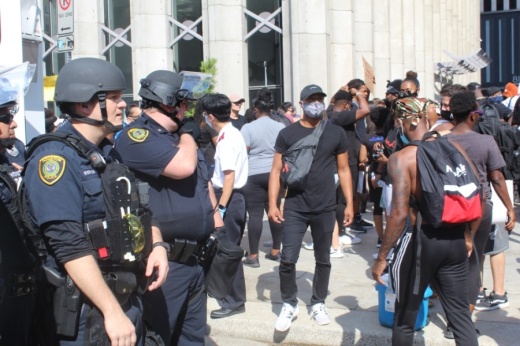After delaying the decision for two weeks, council authorized the police department July 8 to apply for a $2 million federal grant with a $1.9 million match from HPD for new body-worn cameras. Another item, regarding a $166,000 purchase of helmets and shields for the department, was pulled from the agenda.
Council members who called for the delay on the body-worn camera grant vote reversed their positions July 8 to vote in favor of the application.
Originally, Council Member Edward Pollard sought to delay the decision because he said the policies behind the cameras' usage needed to be updated for better transparency.
The Houston Police Department's body-worn camera policy, most of which is dictated by state law, allows the police department’s internal affairs division to flag any video and prevent its release to the public. Houston Police Chief Art Avecedo has prevented the release of videos of several fatal police shootings in recent months; most of them were withheld in response to family members stating a desire to keep them private.
“I don’t see the point in having the technology if it’s of no use to the public,” Pollard said when proposing the postponement June 24.
However, council members ultimately approved the application after discussing further the specifics of the camera system with Houston police representatives.
“I understand now more clearly that we are in dire straits with this equipment,” Council Member Letitia Plummer said. “We need more equipment that is good and state-of-the-art. ... If we don’t have the equipment, we can’t make solid decisions.”
Assistant Police Chief James Jones said at a committee presentation on the body-worn camera program that lagging battery life on the current cameras, which were purchased in 2015, as well as outdated technology are preventing the program from living up to its full potential.
“We are at a point where we now have to consider very quickly to [a request for proposal],” Jones said.”The cameras have a short life span. .... They wear out. They are worn on the officer uniform, so all of them are in use for two to three shifts a day.”
Plummer said she hopes the mayor’s 45-person police reform task force, which meets for the first time July 9 and is set to offer recommendations within 90 days, will lead to reforms regarding body-worn camera policy.
The next point of contention in the discussion came on the purchase of helmets and shields. Council Members Jerry Davis and Tiffany Thomas expressed frustration in response to a lack of transparency surrounding the equipment proposal prior to the council vote and in response to a Twitter post from Acevedo criticizing any questioning of the proposal.
"The thought that in 2020 elected members of city council don’t understand that a protective helmet is needed by police officers is a testament to the loss of common sense in out nation,” read the July 8 tweet, which was accompanied by an image of a police officer with a bloodied head. “We ask children and motorcycle helmets but we question the need for police.”
Council Member Tiffany Thomas said she was offended by the post because she had not been able to reach Acevedo to speak with him privately about the helmet and shield purchase ahead of the vote.
“I was shocked by his tweet regarding an agenda item that was pulled. We get to inquire. We get to ensure that the city of Houston is moving in the right direction," Thomas said. "However, he is not listening. ... We understand the need, but this is also a bargaining tool to demilitarize the police."
Equipment only makes up about 10% of the Houston Police Department fiscal year 2020-21 budget. As much of the equipment supplied by grant applications requires council approval, members use the votes to form a stance on police spending outside of the annual budget vote. Other sources of funding and supplies include millions of dollars worth of donated equipment donated by the U.S. military and earmarks for police facilities and equipment spending in the city’s four-year capital improvement plan.
Mayor Sylvester Turner did not offer an explanation for why the item was pulled—the pull occurred before discussion began; however, he indicated it will reappear on the agenda on a later date.





